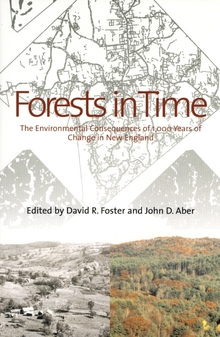Forests in Time
WARNING
You are viewing an older version of the Yalebooks website. Please visit out new website with more updated information and a better user experience: https://www.yalebooks.com
The Environmental Consequences of 1,000 Years of Change in New England
Edited by David R. Foster and John D. Aber
Five thousand years ago, the hemlock collapsed as a result of abrupt global climate change. Now this iconic tree faces extinction once again because of an invasive insect, the hemlock woolly adelgid. Drawing from a century of studies at Harvard University’s Harvard Forest, one of the most well-regarded long-term ecological research programs in North America, the authors explore what hemlock’s modern decline can tell us about the challenges facing nature and society in an era of habitat changes and fragmentation, as well as global change.
"A fascinating account, both technical and very readable, of how time influences life."—Lewis Wolpert, author of The Unnatural Nature of Science
"The inexorable connections between human land use and ecological pattern and flux have been the century-long focus of research and education at the Harvard Forest, which is the ‘center of the universe’ for such scholarship. This volume provides a wonderful synthesis of how the New England landscape has responded to one thousand years of ecological change. It delivers compelling evidence of why historical studies are so relevant to our understanding challenges as diverse as invasive exotic pests and pathogens, nitrogen dynamics, and climate change."—Norman L. Christensen, Duke University, Nicholas School of the Environment and Earth Sciences
"This well-written and timely book addresses an interesting and important topic, the role of human disturbance in transforming the landscape of New England."—Steven Hamburg, Brown University
"This book will serve the wider ecological science and conservation community as a guide to understanding ecological changes on our human dominated planet. It will be a truly extraordinary addition to the literature."—Timothy Fahey, Cornell University
"David Foster and John Aber have produced a marvelous overview of ecological change in New England. Forests in Time represents the cutting edge of efforts to create a truly historical approach to ecological science and should be read by anyone who cares about the past, present, and future of terrestrial ecosystems.”—William Cronon, author of Nature’s Metropolis and Changes in the Land
“Forests in Time is written in a concise and clear style. It can be understood and appreciated by a wide audience, from the weekend naturalist to the professional ecologist. The major strength of the book is that it synthesizes and discusses approximately two decades of intensive research on a wide variety of ecological topics. . . . This book will become a must-read for anyone interested in the study of historical forest ecology and anthropogenic impacts on ecosystem dynamics.”—Marc D. Abrams, BioScience
“With excellent writing and editing, this book synthesizes nearly 100 years of ecological research conducted at Harvard Forest. Much more than a description of research, it provides a framework for ecological studies that is based on an understanding of historical influences on forest structure, composition, and function. . . . It is one of a few select works that documents how the history of land use, climate, physiography, and ecology interact to shape the contemporary landscape. It should therefore be on every forest ecologist’s bookshelf. Highly recommended.”—Choice
"Forests in Time relates the history of natural and human-induced changes that have occurred in the past 1,000 years in New England and explores the modern ecology of this largely forested landscape. ; Written by biological, physical and social scientists, the book demonstrates that an understanding of landscape history is essential for the study of ecology and environmental management."—Connecticut College Magazine
"It is . . . an enormous pleasure to read this beautifully written book."—Michael Hastings, Current Biology
“Foster and Aber have done an excellent job bringing together 20 contributions, from over 50 authors, that tell the story of Harvard Forest and the wider New England forest with all its variety and complexity through time. The individual chapters synthesize and discuss a wealth of material from the primary literature, and a ‘bibliographic essay’ at the end of the book provides a useful, concise guide to their contents. . . . The contributions are readily accessible to the reader, who is aided by a wealth of diagrams, tables, and photographs. Tight editing has ensured uniform terminology and a pleasing coherence of the varied parts. . . . An important and timely addition to a growing literature that documents change and, by implication, underlines our responsibilities to that thing out there that we call ‘nature.’”—Michael Williams, Science
Publication Date: April 27, 2006











